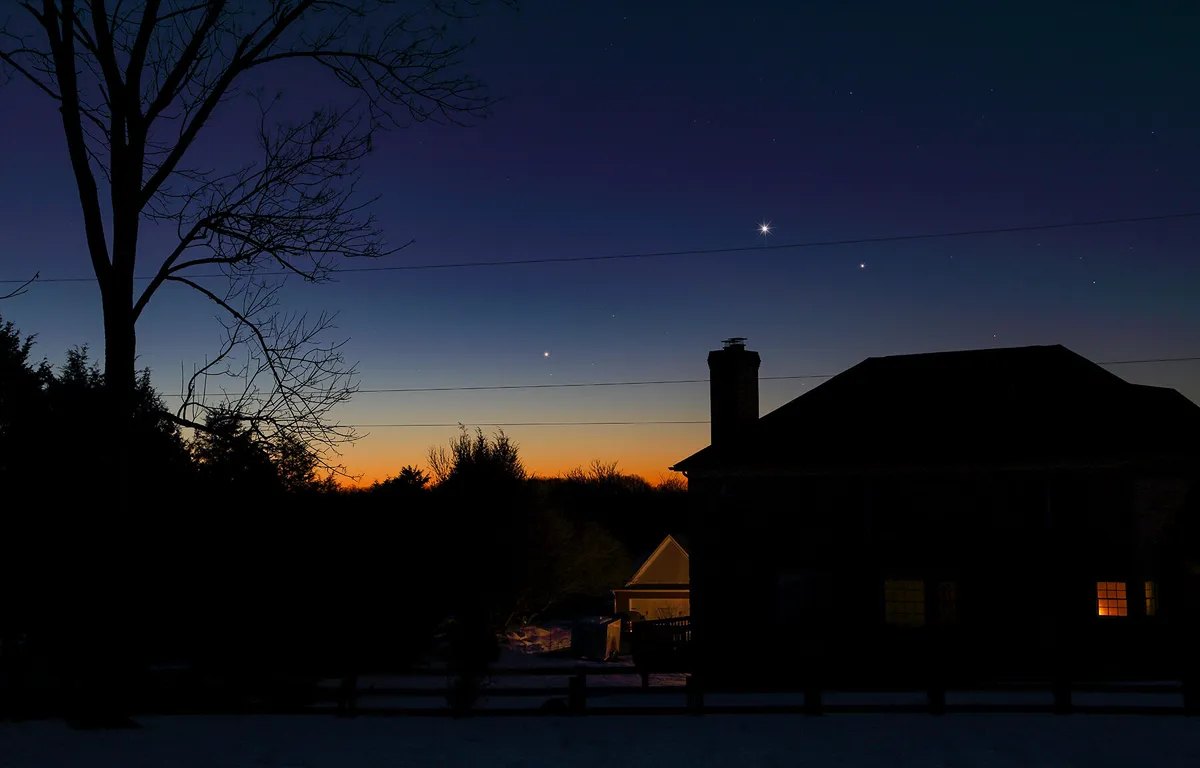All this week, Venus rises in the east and shines like a beautiful 'Morning Star' in the sky just before sunrise.
Venus is often called the 'Morning Star' or the 'Evening Star' because, at its best, it's one of the most beautiful naked-eye objects in the sky, visible in the twilight just after sunset or just before sunrise.
It looks like a bright 'star' in the early evening or early morning, the brightest in the sky and the first one you can see with the naked eye.
Get weekly stargazing advice by signing up to receive the BBC Sky at Night Magazine e-newsletter and subscribing to our YouTube channel

This week, 21–25 April, Venus is bright and beautiful and will be getting closer and closer to the crescent Moon each morning, making for a wonderful sight on 25 April when Venus and the Moon rise together.
You may also have heard that on 25 April, a rare 'smiley face' alignment will be visible.
Here's our morning-by-morning guide to seeing Venus and the Moon this week, and what you can really expect from the 'smiley face' alignment.

Venus rising this week
This week, 21–25 April, Venus rises in the early morning sky just before sunrise. You can see it low in the east from around 05:00, rising higher and higher as the morning progresses.
And because the Sun won't rise until just before 06:00 BST, that means if you have a clear eastern horizon, you'll notice it shining like a bright morning star.
It really will be worth getting up for, if you're not already an early riser.
But a quick note on safety. If you're observing Venus in the morning this week, be aware that it's rising in the same region of the sky as the Sun (albeit just before sunrise).
As a result, care should be taken and you should only observe Venus before the Sun has risen.
Observing the Sun with the naked eye can damage your eyesight, so avoid looking at the eastern horizon at sunrise.
And you should not attempt to observe Venus with binoculars or a telescope either, given its proximity to the Sun.

Venus and the Moon
Venus will rise in the same position in the east every morning this week, but the Moon will track eastward each morning.
This means that, by Friday 25 April, Venus and the Moon will rise together, making for a beautiful morning meeting known as a 'conjunction' in astronomy.
The Moon is also waning. Having been at full Moon on 13 April, it's now becoming a thinner and thinner crescent day after day, approaching new Moon – when it's completely unlit – on Sunday 27 April.
This means the Moon will be a slim crescent this week, but all the more beautiful for it.
23 April

Look to the eastern sky on the morning of 23 April from about 05:00 onwards and you'll see Venus and the crescent Moon rising together.
You'll need a clear horizon to see them both, as they're low down in the sky, and you'll want to catch them before the Sun begins to rise close to 06:00 BST.
The Moon is a quite far away from Venus in the sky this morning, but over the next two mornings, the two will get closer together.
24 April 2025

On 24 April, Venus will rise in the same position in the east around 05:00. But you'll notice the Moon is now closer to Venus than it was the previous morning.
The Moon tracks eastward day after day, meaning it's getting closer and closer to Venus in the eastern sky each morning this week.
And the Moon is also becoming a thinner and thinner crescent as it does so.
It will soon be completely unlit at its 'new Moon' phase, and won't be visible. But that doesn't happen until 27 April, meaning we'll still be able to see the crescent Moon on 25 April, when it has a close encounter with Venus in the morning sky.
25 April and the 'smiley face'

On 25 April, Venus and the Moon rise together, Venus just before the Moon, so that Venus is above the thin crescent Moon in the morning sky.
Again, you'll see them both if you look to the eastern horizon between 05:00 – 05:30 BST. This really will be a beautiful sight, so don't miss it if you have the opportunity to see it.
The proximity of Venus to the crescent Moon has led many to claim that a spectacular 'smiley' face will be visible on the morning of 25 April 2025.
What's this all about? Well, the 'face' will be formed by Venus, the crescent Moon and Saturn.
Venus is one 'eye', Saturn is the other 'eye' and the crescent Moon is the smiley 'mouth'.
In other words, it's a 'smiley face' on its side, rotated clockwise by 90°. You can see what this might look like in our chart above (tilting your head to the right!)
The thing that's spoiling this alignment, however, is the fact that Saturn will be very tricky to see. It's faint – not nearly as bright as Venus – and will be caught in the glare of the Sun.
That smiley face won't be easy to spot – certainly not as 'spectacular' as many are claiming it to be – but it's something to keep an eye out for, to see if you can spot it yourself.
Again, care must be taken as you'll be looking towards the eastern horizon just before sunrise.
By 26 April, Venus is still a prominent, bright object in the morning sky before sunrise, but now the Moon is far to the east of Venus, a very slim crescent and swallowed by the morning glare.
Did you observe Venus and the Moon this week? Did you see the 'smiley face'? Let us know by emailing contactus@skyatnightmagazine.com
